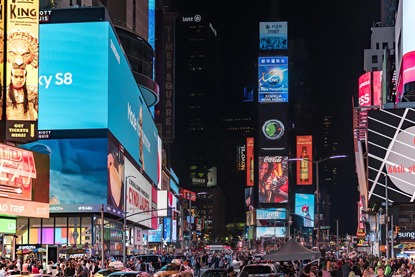How is the LED display becoming?
Before we discuss how the LED display becoming, we need to know the history of the LED display.
LED displays consist of LED lamps and display images and videos for advertising, live shows, messages, and various applications. People use LED displays extensively in various locations, including streets, malls, subway stations, building facades, shows, and exhibition centers.
The LED lamp changed 1960s, and LED technology started.
1980s, the LED panel/ LED screen appeared, but the LED display couldn’t grow fast because there were some technology limitations in the materials and the control system.
LED displays, introduced in the 1990s, initially offered only single or dual colors and were used for messages in places like bus stations, banks, and post offices. The LED lamp used is matrix/ dot technology and DIP technology. The size of the LED lamp is big. And the price of LED screens was high at that time.
In 1999, RGB(Red, Green, Blue) LED lamp technology developed, and the RGB LED lamp started to be used in the markets, it brought the LED display to a full color/RGB time.
In 2001, SMD LED technology emerged, offering a wider viewing angle, efficient production, and lower costs.
Around 2017, GOB and COB technology started to be used on the LED lamp in the market.
-The pixel pitch gets smaller(What is pixel pitch?)
1. In the early stages of the LED screen industry development, manufacturers used to offer LED displays with very high pixel pitches, and they more frequently used LED displays for outdoor billboards. The pixel pitches were like P50 (50mm = P50), P30, P20, and later, they reduced to P16 and P10. These larger pixel pitches continue to find widespread use in billboard and building façade applications. As technology advanced, the pixel pitch decreased, and P8, P6.6, P6, P5, P4, P3 became widely adopted for various outdoor applications, and the prices decreased as well. Media and event/show business owners can buy cheaper LED screens to attract more advertising business from customers. And even more and more end customers can buy an LED screen by themselves at an affordable price.
For the indoor used LED display, they are the same. In the beginning, the pixel pitch was up to P10 for indoor use, a few years later, it came to P8 and P6.6, and P4-P5 is the next step, now, P2.5/P3.9 is very popular and common in the market. In some conference rooms, the pixel pitch can reach values like P1.8, P1.5, P1.2, and even P0.8, but the cost remains significantly high.
-The size of the LED lamp gets smaller(What is an LED lamp?)
As the LED display industry advances, smaller pixel pitches require smaller LED lamp sizes, allowing for more space and easier placement on PCB boards. For the outdoor LED display, the LED lamp to be used is DIP346, SMD3535 for the P10 to P50, SMD2727 for P5 to P8, SMD1921 for P3 to P6, and smaller size LED lamp for smaller pixel pitch, like SMD1415 for P2.5 to P3.
-The cabinet gets smaller and more modular design(What is cabinet?)
For outdoor used products, the size of the cabinet doesn’t change a lot. A few years ago, people widely used 1000x1000mm cabinets for indoor products, but now they prefer 500x500mm cabinets, and some projects require cabinet sizes like 250x1000mm, 250x500mm, and 250x250mm. And for the narrow pixel pitch product, the size is smaller with the golden ratio, like 640x480mm, 600×337.5mm, 400x300mm,
We can easily install and maintain all LED display products because they have a modular design. For instance, one person can install and remove 500x500mm LED panels for an event. If the LED module, receiving card, or power supply has an issue, you can easily replace them with new parts.
With the LED screen industry developing, the cabinet design will be smarter.
-More energy saving
All around the world, including China, people actively encourage energy conservation and environmental protection. LED screens are becoming increasingly prevalent in our daily lives, but people primarily use them for commercial purposes. Consequently, these screens are large and emit high-intensity brightness throughout the entire day, resulting in high power consumption. Besides the initial cost of the LED display, electricity expenses constitute its primary cost component. The power consumption is the main point of the development of the LED display in the future.
The average of the outdoor used LED display is 350W/m², some products can be lower to 150 W/m². Now, more and more companies develop power-cost products.
 Jay
Jay
 Niki
Niki
 Selena
Selena


